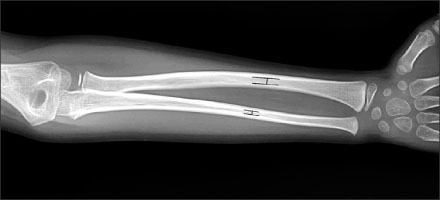J Korean Orthop Assoc.
2009 Aug;44(4):467-472.
The Internal Diameter of the Radius and Ulna in Korean Children
- Affiliations
-
- 1Department of Orthopaedic Surgery, Sang-Gye Paik Hospital, Inje University College of Medicine, Seoul, Korea. yumccf@hanmail.net
Abstract
- PURPOSE
Flexible intramedullary nailing is a advanced method for treating forearm fractures with fewer complications. But sometimes these nails should not be used due to the narrower internal diameter of the forearm bones. We studied the inner diameter of the radius and ulna of children along with their age in relation to the width of the nail. MATERIALS AND METHODS: We reviewed the forearm AP radiographs of all the patients who visited our institute during a specific period, in which their age was between 6 and 19. We measured the inner diameters of the radius and ulna at their narrowest location, and we analyzed the diameter in relation to the patients' age groups, and we compared this data with the width for the nail. RESULTS: A total of 208 patients was included in this study. The inner diameter grew with their increasing age, and the younger the patients, the higher was the rate of inappropriate use of the nail. On linear regression analysis, the age plus or minus 1 SD for usage of the ready-made nail was 12.6 years-old for the male radius. CONCLUSION: The nail was sometimes too thick for the diameter of the forearm bones of Korean children. It is correct for the surgeon to select whatever material to fix the fracture, but appropriate thickness of the nail should be selected thoughtfully in preoperative planning.
Figure
Reference
-
1. Cheng J, Ng B, Ying SA, Lam PK. A 10-year study of the changes in the pattern and treatment of 6,493 fractures. J Pediatr Orthop. 1999. 19:344–350.
Article2. Lascombes P, Prevot J, Ligier JN, Metaizeau JP, Poncelet T. Elastic stable intramedullary nailing in forearm shaft fractures in children: 85 cases. J Pediatr Orthop. 1990. 10:167–171.
Article3. Pugh DM, Galpin RD, Carey TP. Intramedullary Steinmann pin fixation of forearm fractures in children. Long-term results. Clin Orthop Relat Res. 2000. 376:39–48.4. Smith VA, Goodman HJ, Strongwater A, Smith B. Treatment of pediatric both-bone forearm fractures: a comparison of operative techniques. J Pediatr Orthop. 2005. 25:309–313.5. Ogonda L, Wong-Chung J, Wray R, Canavan B. Delayed union and non-union of the ulna following intramedullary nailing in children. J Ped Orthop. 2004. 13:330–333.
Article6. Synthes®. Traumatology and General Osteosynthesis, Catalog. 2006. 7:M edition. Philadelphia: Synthes;50–54.7. Majed A, Baco AM. Nancy nail versus intramedullary-wire fixation of paediatric forearm fractures. J Pediatr Orthop B. 2007. 16:129–132.
Article8. Shoemaker SD, Comstock CP, Mubarak SJ, Wenger DR, Chambers HG. Intramedullary Kirschner wire fixation of open or unstable forearm fractures in children. J Pediatr Orthop. 1999. 19:329–337.
Article9. Van der Reis WL, Otsuka NY, Moroz P, Mah J. Intramedullary nailing versus plate fixation for unstable forearm fractures in children. J Pediatr Orthop. 1998. 18:9–13.
Article10. Chitgopkar SD. Flexible nailing of fractures in children using stainless steel Kirschner wires. J Pediatr Orthop B. 2008. 17:251–255.
Article11. Calder PR, Achan P, Barry M. Diaphyseal forearm fracture in children treated with intramedullary fixation, Outcome of K-wire versus elastic stable intramedullary nail. Int J Care Injured. 2003. 34:278–282.12. Bass S, Delmas PD, Pearce G, Hendrich E, Tabensky A, Seeman E. The differing tempo of growth in bone size, mass, and density in girls is region-specific. J Clin Invest. 1999. 104:795–804.
Article13. Neu CM, Rauch F, Manz F, Schoenau E. Modeling of cross-sectional bone size, mass and geometry at the proximal radius: a study of normal bone development using peripheral quantitative computed tomography. Osteoporos Int. 2001. 12:538–547.
Article
- Full Text Links
- Actions
-
Cited
- CITED
-
- Close
- Share
- Similar articles
-
- Congenital Pseudarthrosis of Bones of the Forearm: A Case Report
- Treatment of Diaphyseal Fractures of the Radius and Ulna with Dynamic Compression Plates: A Retrospective Study of 52 Fractures in 33 Patients
- On Reconstion with Bone Graft of the Defect of Radus: Report of 2 Cases
- The correlation between the length of the humerus, ulna and radius in Korean adults and fetuses.
- Lengthening and Deformity Correction of the Forearm by Callotasis




